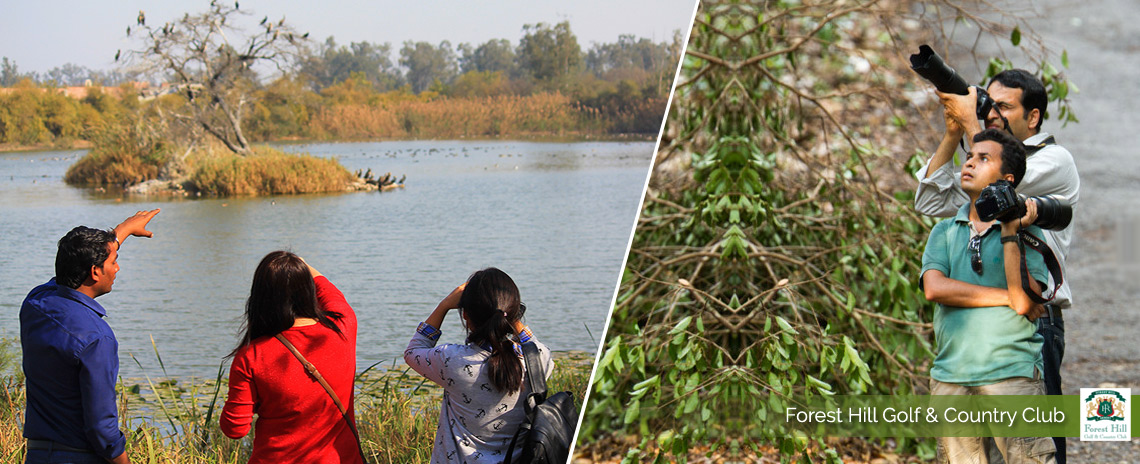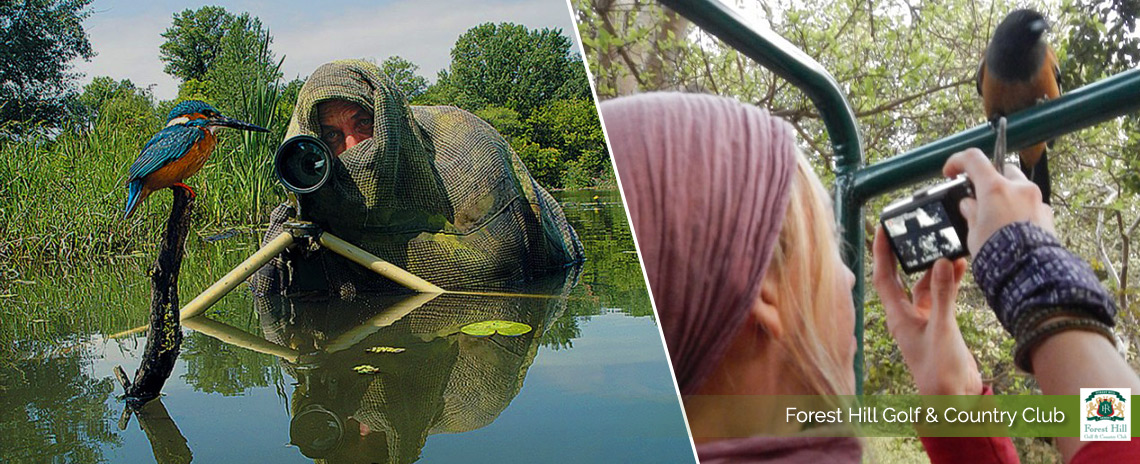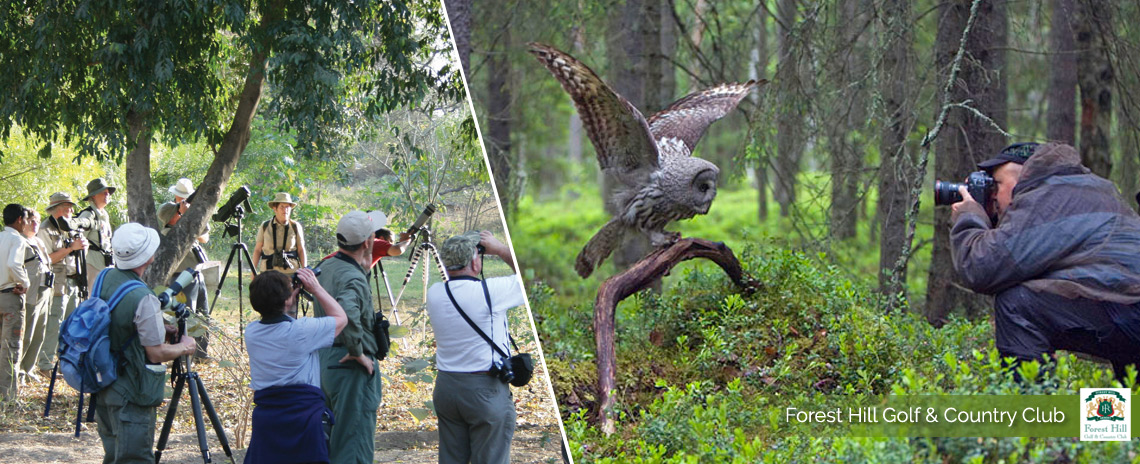Forest Hill Golf & Country Club is a haven for bird species. Almost 500 species of birds can be found here that include resident breeders as well as migratory species. Brown-headed Barbet, Asian paradise flycatcher, White-capped redstart, and Indian Peacock are very few of the many species which can be found here
Common species of bird found at FHR
Asian Paradise Flycatcher

A resident breeder, it's seen in local parks in winter but moves uphill for breeding, Long-Tailed, it is called shah bulbul in Hindi & Punjabi
Males have elongated central tail feathers, and a black and rufous plumage in some populations, while others have white plumage. Females are short-tailed with rufous wings and a black head. Indian paradise flycatchers feed on insects, which they capture in the air often below a densely canopied tree.
Fire Breasted FlowerPecker
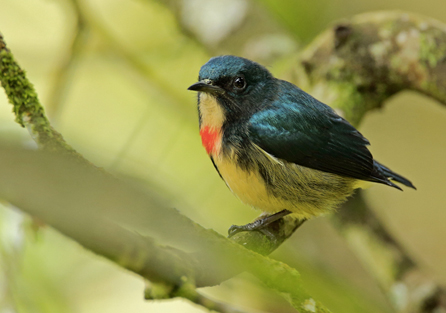
A resident breeder, it is a nectar-sipping bird with beautiful colours.
The fire-breasted flowerpecker is a small flowerpecker with a small and dark bill. The male has glossy blue-black upperparts. The underside is buffy but a bright red breast patch. Starting below it and along the middle is a short black stripe going down till the belly. The female is dark olive above and buff below. The sides are olive and the bill has a pale base
Blue-Throated Barbet
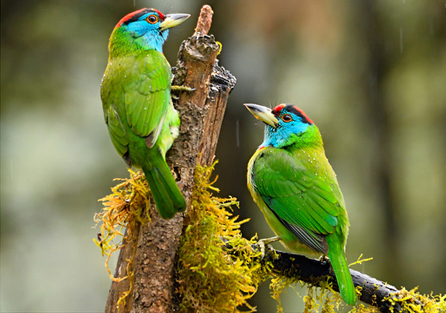
A resident breeder, it is a frugivorous bird found in broad-leaved forests.
The barbets get their name from the bristles which fringe their heavy bills; this species eats fruits and insects. They frequent evergreen forests, deciduous forests, gardens, orchards, teak forests and cities with fruiting trees.
Common Kestrel
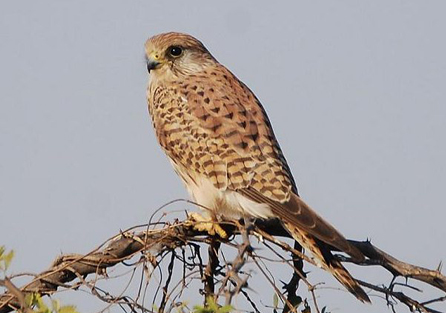
A raptor, it is a winter migrant from the middle & higher Himalayas to the inter-state Chandigarh region.
Their plumage is mainly light chestnut brown with blackish spots on the upperside and buff with narrow blackish streaks on the underside; the remiges are also blackish
Indian Owl

It is a noctumal bird that possesses large forward- facing eyes and ear-holes; a hawk-like beak; a flat face; and usually a conspicuous circle of feathers, a facial disc, around each eye.
Most owls are nocturnal, actively hunting their prey in darkness. Several types of owls, however, are crepuscular—active during the twilight hours of dawn and dusk
White-browed shrike babbler
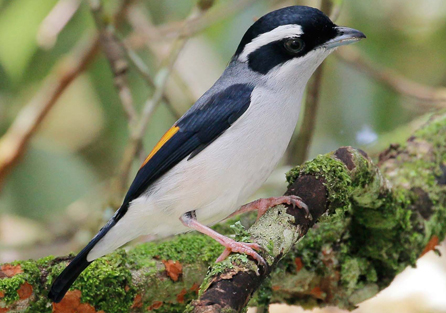
A resident breeder in the region, this colourful bird is an insectivorous found in evergreen forests.
The Himalayan shrike-babbler (Pteruthius ripleyi) is a bird species found in the western Himalayas that belongs to the shrike-babbler group. The genus was once considered to be an aberrant Old World babbler and placed in the family Timaliidae until molecular phylogenetic studies showed them to be closely related to the vireos of the New World, leading to their addition in the family Vireonidae.
Green Tailed Sunbird
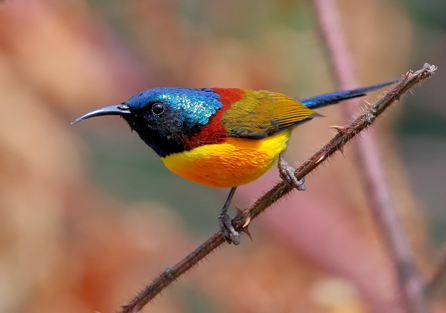
A might from the middle and higher Himalayas, it is a nectar-sucking bird found in the broad-leaved forests.
The green-tailed sunbird yellow-backed sunbird is a species of bird in the family Nectariniidae. It is found in the northern regions of the Indian subcontinent, stretching eastwards into parts of Southeast Asia. Its natural habitats are temperate forests and subtropical or tropical moist montane forests
Brown Headed barbet
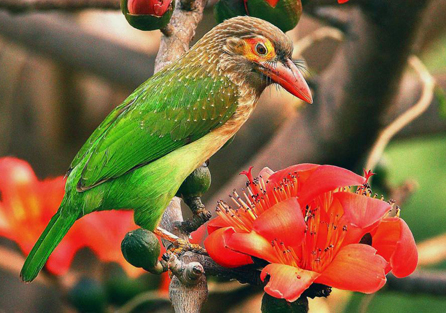
A resident breeder, it is a frugivorous bird and can heard in spring, calling "Kutroo Kutroo Kutruk" and is called basanta in Hindi & Punjabi.
It forages on mangos, ripe jackfruit, papaya, banana, figs and similar cultivated fruit trees. Its habitat includes urban and country gardens though it tends to eschew heavy forest. It nests in a suitable hole in a tree that it will often excavate. Both sexes incubate the eggs and often communicate with each other using their Kura, kura calls.
Jungle Fowl

There are large birds, with colourful male plumage, but are difficult to see in the dense vegetation they inhabit. They are seed-eaters, but insects are also taken, particularly by the young birds.
These are large birds, with colourful plumage in males, but are nevertheless difficult to see in the dense vegetation they inhabit.
Plum Headed Parakeet
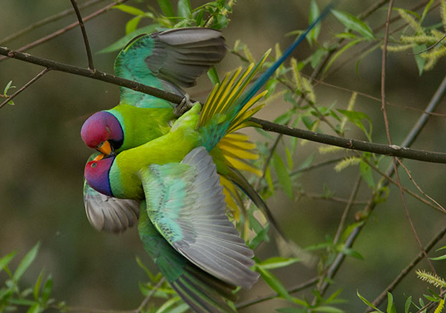
A frugivorous bird found in large flocks, it is a resident breeder in the region.
Both genders are black with red underparts and white crown atop their heads. Males have larger white pattern on top of the head and brown red spots under the wings.
White Capped Redstart
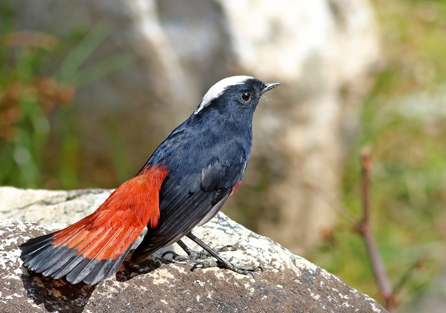
A resident breeder, it is found near streams and rivers. It has white cap, black rest of head to back and wings and down to breast it is red, Its natural habitat is temperate forests. It is found in the Indian Subcontinent and Southeast Asia, as well as some adjoining areas.
Indian Peacock
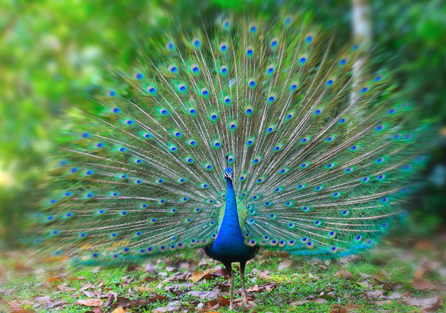
A resident breeder Peacocks are large, colorful pheasants (typically blue and green) known for their
The male, or peacock, is predominantly blue with a fan-like crest of spatula-tipped wire-like feathers and is best known for the long train made up of elongated upper-tail covert feathers which bear colourful eyespots. These stiff feathers are raised into a fan and quivered in a display during courtship.
Despite the length and size of these covert feathers, peacocks are still capable of flight. Peahens lack the train, and have a greenish lower neck and duller brown plumage.
Plumbeous Water Redstart
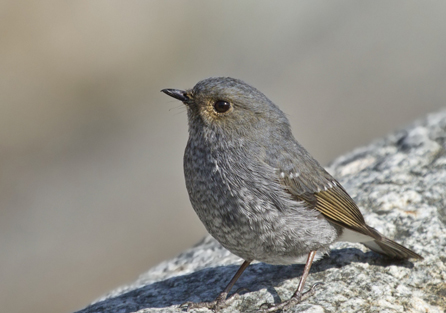
A resident breeder it is found near streams and rivers, while females are grey.
The plumbeous water redstart belongs to the order Passeriformes and the family Muscicapidae. It was previously placed in the genus Rhyacornis but was moved to Phoenicurus based on the results of a molecular phylogenetic study published in 2010
The plumbeous water redstart is very protective of its habitat and will be extremely confrontational to any trespasser on its territory. In order to catch flies in rivers, it flies vertically until it is at least 20 feet above the water, before gliding down in a spiral back to the same place.
Common Quail
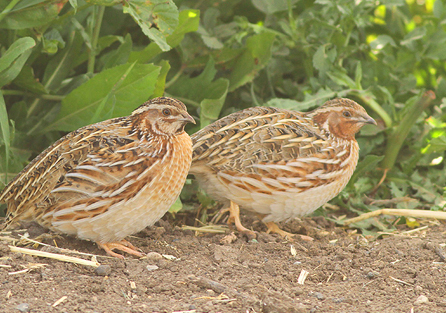
It is a small, round bird, essentially streaked brown with a white eyestripe, and, in the male, a white chin. As befits its migratory nature, it has long wings, unlike the typically short-winged game birds.
It is a small, round bird, essentially streaked brown with a white eyestripe, and, in the male, a white chin. As befits its migratory nature, it has long wings, unlike the typically short-winged gamebirds.
This is a terrestrial species, feeding on seeds and insects on the ground. It is notoriously difficult to see, keeping hidden in crops, and reluctant to fly, preferring to creep away instead. Even when flushed
Indian Pitta
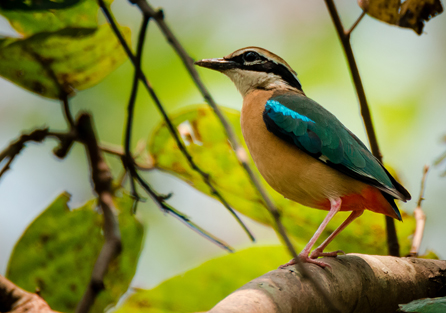
It is a summer migrant. It is called nauranga In Hindi and Punjab & is a beautifully coloured bird
The Indian pitta (Pitta brachyura) is a passerine bird native to the Indian subcontinent. It inhabits scrub jungle, deciduous and dense evergreen forest. It breeds in the forests of the Himalayas, hills of central and western India, and migrates to other parts of the peninsula in winter.
Although very colourful, it is usually shy and hidden in the undergrowth where it picks insects on the forest floor. It has a distinctive two note whistling call which is heard at dawn and dusk
Black Winged Stilt
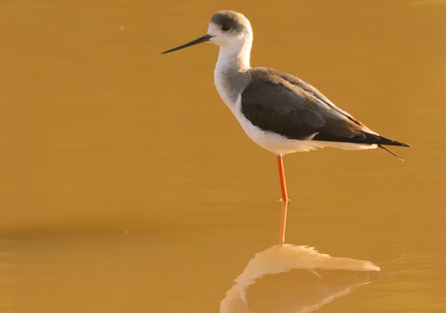
Adults are 33–36 cm (13–14 in) long. They have long pink legs, a long thin black bill and are blackish above and white below, with a white head and neck with a varying amount of black. Males have a black back, often with greenish gloss. Females' backs have a brown hue, contrasting with the black remiges.
In the populations that have the top of the head normally white at least in winter, females tend to have less black on head and neck all year round, while males often have much black, particularly in summer.
Immature birds are grey instead of black and have a markedly sandy hue on the wings, with light feather fringes appearing as a whitish line in flight.
Common Pochard
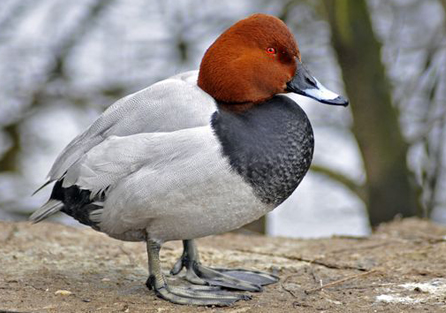
The adult male has a long dark bill with a grey band, a red head and neck, a black breast, red eyes and a grey back. The adult female has a brown head and body and a narrower grey bill-band. The triangular head shape is distinctive.
These are gregarious birds, forming large flocks in winter, often mixed with other diving ducks such as the tufted duck, with which they are known to hybridise.
In number of countries the population of Common Pochard is decreasing mainly due to urbanization of the natural habitats and their transformation, as well as due to overhunting.
Little Black Cormorant
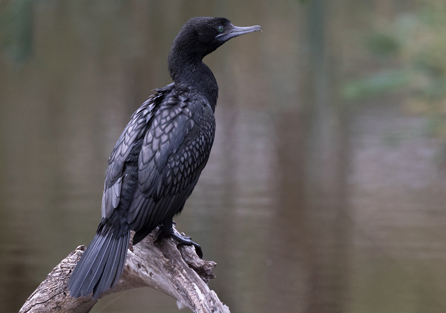
The little black cormorant is a small cormorant measuring 60–65 cm (23.5–25.5 in) with all black plumage. The back has a greenish sheen. In breeding season, white feathers appear irregularly about the head and neck, with a whitish eyebrow evident. The plumage is a more fade brown afterwards. Males and females are identical in plumage. The long slender bill is grey, and legs and feet black. The iris of the adult is green and the juvenile brown. Immature birds have brown and black plumage.
More gregarious than other cormorants, the little black cormorant can be found in large flocks. Groups sometimes fly in V formations.
Cinereous Tit

The cinereous tit (Parus cinereus) is a species of bird in the tit family Paridae. This species is made up of several populations that were earlier treated as subspecies of the great tit (Parus major). These birds are grey backed with white undersides. The great tit in the new sense is distinguishable by the greenish-back and yellowish underside
This tit is part of a confusing group of species but is distinct in having a grey-back, black hood, white cheek patch and a white wing-bar. The underparts are white with the black central stripe running along the length. The female has a narrower ventral line and is slightly duller.
Spotted Owlet

The spotted owlet (Athene brama) is a small owl which breeds in tropical Asia from mainland India to Southeast Asia. A common resident of open habitats including farmland and human habitation, it has adapted to living in cities. They roost in small groups in the hollows of trees or in cavities in rocks or buildings. It nests in a hole in a tree or building, laying 3–5 eggs. They are often found near human habitation. The species shows great variation including clinal variation in size and forms a superspecies with the very similar little owl.
The spotted owlet is a small and stocky bird, barely 21 centimetres (8.3 in) in size. The upperparts are grey-brown, heavily spotted with white. The underparts are white, streaked with brown. The facial disc is pale and the iris is yellow. There is a white neckband and supercilium. Sexes are similar.
White Throated Fantail
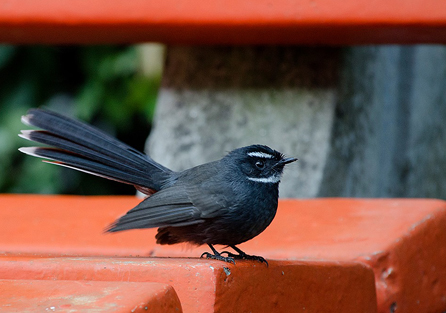
The adult white-throated fantail is about 19 cm long. It has a dark fan-shaped tail, edged in white, and white supercilium and throat. There is otherwise much variation in plumage between races.
Birds use the same song year after year, with progressively small changes, with the result that the song sounds very different after 4–5 years. The male's call is a valuable tool in detection and identification of the bird, which can often be confused with the white-browed fantail, R. aureola, where their ranges overlap.

